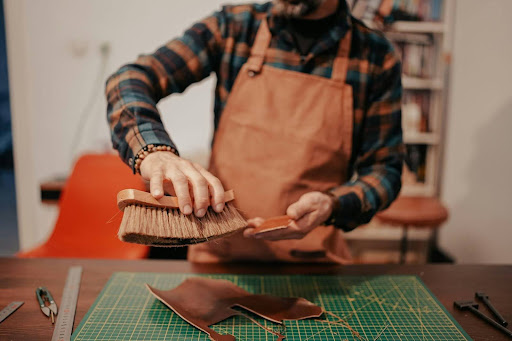In an era of same-day delivery, automation, and AI-generated design, it would be easy to assume that traditional craftsmanship is fading into the past. But that couldn’t be further from the truth. Today, many artisan businesses are not only surviving in the digital economy—they’re thriving. Their success lies in adapting their time-honored techniques to the needs of a fast-paced world while maintaining the authenticity that sets them apart.
One such example is Aran, a company rooted in Ireland’s long-standing knitting tradition. Known for its intricate cable-knit patterns and cultural legacy, Aran has managed to evolve from heritage-based production into a global brand that resonates with modern consumers. And they’re not alone.
This article explores how traditional craftsmanship continues to find relevance, market share, and cultural value in a digital-first world.
The Shift from Utility to Identity
Craftsmanship once served practical needs: people wove, carved, stitched, or forged to survive. Today, traditional goods often signify something deeper—identity, values, heritage. When consumers choose a handmade ceramic mug over a mass-produced one, they’re not just selecting a product; they’re making a statement.
Modern buyers want to know where things come from, who made them, and how. This preference has led to a resurgence of interest in artisanal products, which emphasize transparency, origin, and emotional connection.
According to a report by the U.S. Small Business Administration, consumer trends are increasingly favoring local and handmade goods as symbols of quality and authenticity. These values are reshaping purchasing behaviors across industries—from food to fashion to home goods.
Digital Tools, Human Touch
The idea that craftsmanship and technology are mutually exclusive is outdated. In fact, the digital economy has opened up unprecedented opportunities for artisans:
- E-commerce platforms allow craftspeople to reach global audiences without retail overhead.
- Social media marketing offers a low-cost way to tell brand stories.
- AI tools and CRMs streamline operations and customer engagement.
Even traditional artisans who might have relied solely on word-of-mouth can now showcase their work through professional-grade websites, influencer partnerships, and content marketing. This synergy between old and new empowers small producers to maintain integrity while growing their reach.
Why People Still Crave the Handmade
Despite the rise of fast everything—fast fashion, fast food, fast information—consumers are showing signs of fatigue. There is a growing demand for products that carry weight, meaning, and intention.
Handcrafted items often bring:
- Emotional resonance: They remind people of family, roots, or history.
- Durability and quality: Made to last, unlike many mass-produced goods.
- Ethical value: They often align with sustainability and fair labor practices.
This explains why brands built on heritage, like Aran, continue to flourish in modern contexts. These companies preserve old-world techniques while modernizing access.
Challenges in the Craft Economy
While many traditional businesses are thriving, the journey isn’t without challenges:
- Scaling: Handmade goods inherently limit output. Brands must decide whether to scale or stay niche.
- Cost vs. Price: Artisans often struggle to price competitively while covering the cost of skilled labor.
- Authenticity fatigue: With the rise of faux “handmade” branding, consumers are becoming skeptical.
Solutions include limited-edition drops, transparent storytelling, and collaborations with digital influencers or like-minded companies. In some cases, brands have educated customers about the value of slow production—creating loyal communities willing to invest more for quality.
How Technology Preserves Tradition
Image from Unsplash
Technology isn’t the enemy of heritage—it’s its ally. Tools such as 3D scanning, cloud-based inventory management, and virtual workshops are being adopted to:
- Archive traditional patterns and techniques
- Teach skills through digital platforms
- Reach niche audiences via targeted content
Machine-learning algorithms can even help analyze historical trends in color, texture, or form—empowering artisans to design products that resonate both culturally and commercially.
Cultural Continuity and Global Storytelling
Craftsmanship often reflects local culture—but digital access makes that culture visible to the world. When a shopper in New York purchases a handwoven sweater from Ireland, they’re not just buying warmth. They’re buying narrative, geography, and meaning.
This globalization of stories allows:
- Cultural preservation through commerce
- Intergenerational skill sharing via online learning
- Wider recognition of marginalized artisans and traditions
It also opens the door for innovation—combining techniques from different regions or collaborating across borders to create new hybrid traditions.
The Future: Coexistence, Not Competition
Digital tools and traditional skills aren’t in conflict. They’re part of the same continuum. As more consumers seek out products with meaning, and as technology becomes more user-friendly, the line between digital and analog continues to blur.
Tomorrow’s successful brands will likely be those that:
- Embrace new technology without losing their roots
- Tell honest stories
- Deliver craftsmanship with convenience
Traditional doesn’t have to mean outdated. In many ways, it means enduring. And in a world chasing novelty, endurance is rare—and valuable.
Craftsmanship is not dying. It’s digitizing.
And as it does, it reveals a compelling truth: that sometimes the best way forward is to look back—then bring that story online.

